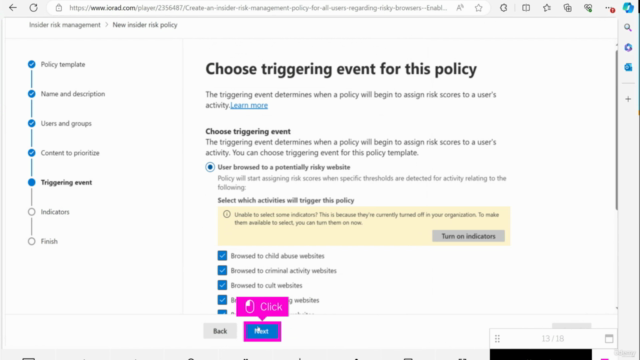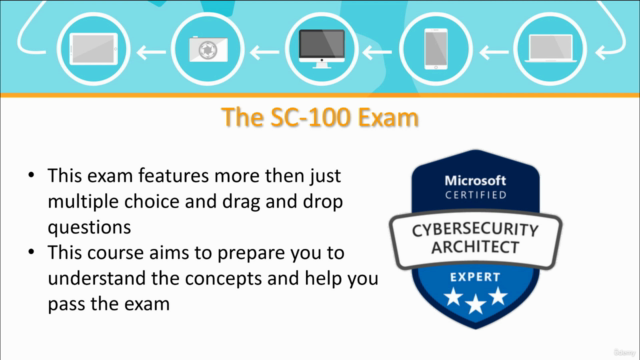SC-100 Microsoft Cybersecurity Architect course with sims

Why take this course?
Based on the outline you've provided, it seems like you're looking to cover a comprehensive range of topics within Microsoft cybersecurity solutions, focusing on both cloud and endpoint security. Here's a brief explanation of each topic that fits into the overall theme of understanding and implementing Microsoft cybersecurity solutions:
-
Understanding the Cybersecurity Threat Landscape: This section would introduce the types of threats organizations face today, including traditional threats like malware, phishing, and insider threats, as well as newer challenges such as advanced persistent threats (APTs), ransomware, and nation-state actors.
-
Azure Security, Identity, and Compliance: This topic would delve into the security features and services available within Azure, including Azure Active Directory (Azure AD) for identity management, Azure Security Center for monitoring and securing Azure resources, and compliance tools to ensure that your infrastructure adheres to regulatory standards.
-
Design solutions for identity and access management: Here, you would explore how to implement identity governance with Microsoft Entra (formerly known as Azure Active Directory External Identities), including entitlement management, user access requests, and privilege management.
-
Design solutions for regulatory compliance: This section would cover how to use Microsoft Purview (formerly Compliance Manager) for data governance and privacy, Microsoft Priva for managing privacy risks, Azure Policy for enforcing compliance, and how Microsoft Defender for Cloud assists in compliance.
-
Endpoint Security with Microsoft 365: You would learn about the various endpoint protection solutions provided by Microsoft 365, including advanced threat protection, email filtering, encryption, and data loss prevention measures that can be deployed to protect endpoints from cyber threats.
-
Design solutions for securing an organization's data: This topic would cover data discovery, classification with Microsoft Purview, data governance with sensitivity labels, and how to secure data at rest, in motion, and in use with Azure services.
-
Implementing Microsoft Cloud Solutions: This section would guide learners through the implementation of various cloud services such as Microsoft Azure, Microsoft 365 (Office 365), Dynamics 365, Power BI, Cortana, and Microsoft Defender for securing data and applications in the cloud.
-
Implementing Microsoft Endpoint Security Solutions: This section would cover the various endpoint protection solutions provided by Microsoft for protecting endpoints from cyber threats such as Microsoft Defender Advanced Threat Protection (ATP), Email Filtering, Encryption, Data Loss Prevention Measures, and Application Control.
-
Understanding and Implementing Data Security Solutions: This section would cover understanding and implementing data security solutions with various Microsoft Azure services such as Microsoft Azure SQL Database, Cosmos DB API, Azure Synapse Analytics, Azure Blob Storage, Azure File Storage, Azure Queue Storage Service Bus, and Event Processing.
-
Conclusion: In the conclusion of this learning path, you would summarize all the topics learned throughout this course. Additionally, you would cover cleaning up resources that were used during the course to ensure there are no unnecessary resources consuming computational and financial resources needlessly. As a learner, after completing the course and understanding Microsoft cybersecurity solutions, here's what you can do next:
- Apply Knowledge: Start applying the knowledge from this course to your current role or job, enhancing the security posture of your organization.
- Stay Updated: Cybersecurity is a constantly evolving field. Stay updated with the latest trends, technologies, and best practices in cybersecurity by attending webinars, online courses, reading research papers, and participating in cybersecurity communities and forums.
- Advance Career: Consider advancing your career by obtaining relevant professional certifications such as Microsoft Certified: Azure Administrator Associate (Azure A10), Microsoft Certified: Azure Security Engineer Exam (AZ-500), Microsoft 365 Certification, and CompTIA certifications such as CompTIA Security+ (SEC+), CompTIA Cisco Certified Network Associate (CCNA), and CompTIA Certified Information Systems Professional (CISSP). Remember, the field of cybersecurity is vast and requires continuous learning to stay ahead of potential threats. Stay vigilant, keep learning, and apply best practices in cybersecurity to protect your organization's critical assets from potential cyber threats.
Course Gallery




Loading charts...